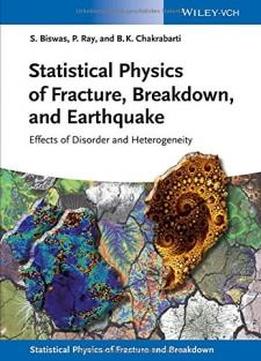
Statistical Physics Of Fracture, Beakdown, And Earthquake: Effects Of Disorder And Heterogeneity (statistical Physics Of Fracture And Breakdown)
by Bikas K. Chakrabarti /
2015 / English / PDF
8.5 MB Download
In this book, the authors bring together basic ideas from fracture
mechanics and statistical physics, classical theories, simulation
and experimental results to make the statistical physics aspects of
fracture more accessible. They explain fracture-like phenomena,
highlighting the role of disorder and heterogeneity from a
statistical physical viewpoint. The role of defects is discussed in
brittle and ductile fracture, ductile to brittle transition,
fracture dynamics, failure processes with tension as well as
compression: experiments, failure of electrical networks,
self-organized critical models of earthquake and their extensions
to capture the physics of earthquake dynamics. The text also
includes a discussion of dynamical transitions in fracture
propagation in theory and experiments, as well as an outline of
analytical results in fiber bundle model dynamics With its wide
scope, in addition to the statistical physics community, the
material here is equally accessible to engineers, earth scientists,
mechanical engineers, and material scientists. It also serves as a
textbook for graduate students and researchers in physics.
In this book, the authors bring together basic ideas from fracture
mechanics and statistical physics, classical theories, simulation
and experimental results to make the statistical physics aspects of
fracture more accessible. They explain fracture-like phenomena,
highlighting the role of disorder and heterogeneity from a
statistical physical viewpoint. The role of defects is discussed in
brittle and ductile fracture, ductile to brittle transition,
fracture dynamics, failure processes with tension as well as
compression: experiments, failure of electrical networks,
self-organized critical models of earthquake and their extensions
to capture the physics of earthquake dynamics. The text also
includes a discussion of dynamical transitions in fracture
propagation in theory and experiments, as well as an outline of
analytical results in fiber bundle model dynamics With its wide
scope, in addition to the statistical physics community, the
material here is equally accessible to engineers, earth scientists,
mechanical engineers, and material scientists. It also serves as a
textbook for graduate students and researchers in physics.











